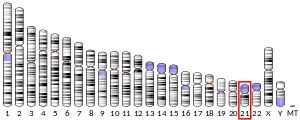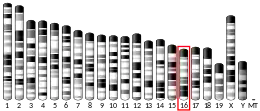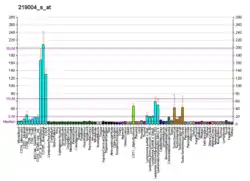MIS18A
Protein Mis18-alpha is a protein that in humans is encoded by the MIS18A gene.[5][6]
| MIS18A | |||||||||||||||||||||||||||||||||||||||||||||||||||
|---|---|---|---|---|---|---|---|---|---|---|---|---|---|---|---|---|---|---|---|---|---|---|---|---|---|---|---|---|---|---|---|---|---|---|---|---|---|---|---|---|---|---|---|---|---|---|---|---|---|---|---|
| Identifiers | |||||||||||||||||||||||||||||||||||||||||||||||||||
| Aliases | MIS18A, B28, C21orf45, C21orf46, FASP1, MIS18alpha, hMis18alpha, MIS18 kinetochore protein A | ||||||||||||||||||||||||||||||||||||||||||||||||||
| External IDs | OMIM: 618137 MGI: 1913828 HomoloGene: 41294 GeneCards: MIS18A | ||||||||||||||||||||||||||||||||||||||||||||||||||
| |||||||||||||||||||||||||||||||||||||||||||||||||||
| |||||||||||||||||||||||||||||||||||||||||||||||||||
| |||||||||||||||||||||||||||||||||||||||||||||||||||
| |||||||||||||||||||||||||||||||||||||||||||||||||||
| |||||||||||||||||||||||||||||||||||||||||||||||||||
| Wikidata | |||||||||||||||||||||||||||||||||||||||||||||||||||
| |||||||||||||||||||||||||||||||||||||||||||||||||||
References
- GRCh38: Ensembl release 89: ENSG00000159055 - Ensembl, May 2017
- GRCm38: Ensembl release 89: ENSMUSG00000022978 - Ensembl, May 2017
- "Human PubMed Reference:". National Center for Biotechnology Information, U.S. National Library of Medicine.
- "Mouse PubMed Reference:". National Center for Biotechnology Information, U.S. National Library of Medicine.
- Fujita Y, Hayashi T, Kiyomitsu T, Toyoda Y, Kokubu A, Obuse C, Yanagida M (Jan 2007). "Priming of centromere for CENP-A recruitment by human hMis18alpha, hMis18beta, and M18BP1". Developmental Cell. 12 (1): 17–30. doi:10.1016/j.devcel.2006.11.002. PMID 17199038.
- "Entrez Gene: C21orf45 chromosome 21 open reading frame 45".
External links
- Human MIS18A genome location and MIS18A gene details page in the UCSC Genome Browser.
Further reading
- Slavov D, Hattori M, Sakaki Y, Rosenthal A, Shimizu N, Minoshima S, Kudoh J, Yaspo ML, Ramser J, Reinhardt R, Reimer C, Clancy K, Rynditch A, Gardiner K (Apr 2000). "Criteria for gene identification and features of genome organization: analysis of 6.5 Mb of DNA sequence from human chromosome 21". Gene. 247 (1–2): 215–32. doi:10.1016/S0378-1119(00)00089-5. PMID 10773462.
- Hattori M, Fujiyama A, Taylor TD, Watanabe H, Yada T, Park HS, Toyoda A, Ishii K, Totoki Y, Choi DK, Groner Y, Soeda E, Ohki M, Takagi T, Sakaki Y, Taudien S, Blechschmidt K, Polley A, Menzel U, Delabar J, Kumpf K, Lehmann R, Patterson D, Reichwald K, Rump A, Schillhabel M, Schudy A, Zimmermann W, Rosenthal A, Kudoh J, Schibuya K, Kawasaki K, Asakawa S, Shintani A, Sasaki T, Nagamine K, Mitsuyama S, Antonarakis SE, Minoshima S, Shimizu N, Nordsiek G, Hornischer K, Brant P, Scharfe M, Schon O, Desario A, Reichelt J, Kauer G, Blocker H, Ramser J, Beck A, Klages S, Hennig S, Riesselmann L, Dagand E, Haaf T, Wehrmeyer S, Borzym K, Gardiner K, Nizetic D, Francis F, Lehrach H, Reinhardt R, Yaspo ML (May 2000). "The DNA sequence of human chromosome 21". Nature. 405 (6784): 311–9. Bibcode:2000Natur.405..311H. doi:10.1038/35012518. PMID 10830953.
- Dowler S, Currie RA, Campbell DG, Deak M, Kular G, Downes CP, Alessi DR (Oct 2000). "Identification of pleckstrin-homology-domain-containing proteins with novel phosphoinositide-binding specificities". The Biochemical Journal. 351 (Pt 1): 19–31. doi:10.1042/0264-6021:3510019. PMC 1221362. PMID 11001876.
- Gardiner K, Slavov D, Bechtel L, Davisson M (Jun 2002). "Annotation of human chromosome 21 for relevance to Down syndrome: gene structure and expression analysis". Genomics. 79 (6): 833–43. doi:10.1006/geno.2002.6782. PMID 12036298.
- Ye XX, Lu H, Yu Y, Ding N, Zhang NL, Huo KK, Wan DF, Li YY, Gu JR (Mar 2005). "P5644 interacts with phosphatidylinositol-4-phosphate adaptor protein-1 associated protein-1". Molecular and Cellular Biochemistry. 271 (1–2): 151–8. doi:10.1007/s11010-005-5907-6. PMID 15881666. S2CID 2101296.
- Otsuki T, Ota T, Nishikawa T, Hayashi K, Suzuki Y, Yamamoto J, Wakamatsu A, Kimura K, Sakamoto K, Hatano N, Kawai Y, Ishii S, Saito K, Kojima S, Sugiyama T, Ono T, Okano K, Yoshikawa Y, Aotsuka S, Sasaki N, Hattori A, Okumura K, Nagai K, Sugano S, Isogai T (2007). "Signal sequence and keyword trap in silico for selection of full-length human cDNAs encoding secretion or membrane proteins from oligo-capped cDNA libraries". DNA Research. 12 (2): 117–26. doi:10.1093/dnares/12.2.117. PMID 16303743.
This article is issued from Wikipedia. The text is licensed under Creative Commons - Attribution - Sharealike. Additional terms may apply for the media files.




